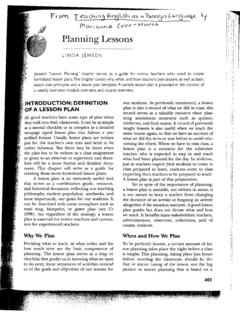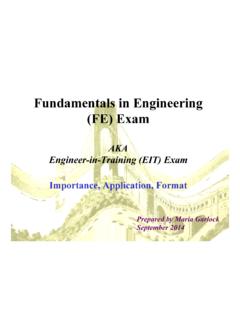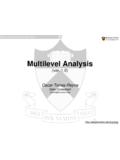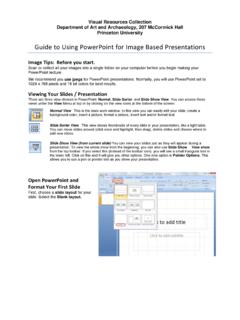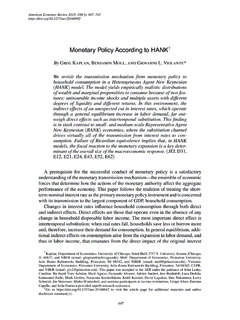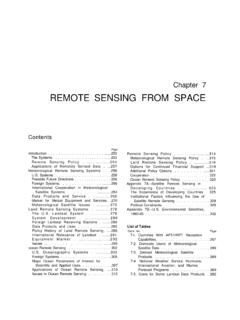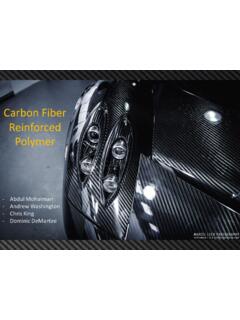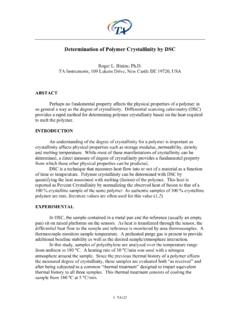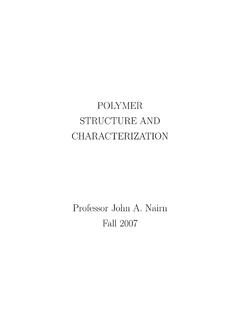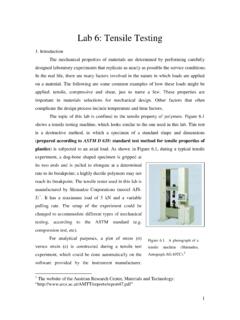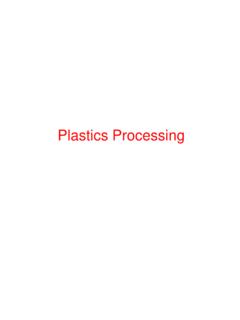Transcription of Polymer Matrix Composites - Princeton University
1 Chapter 3 Polymer 3 Polymer Matrix CompositesFINDINGSP olymer Matrix Composites (PMCs) are com-prised of a variety of short or continuous fibersbound together by an organic Polymer a ceramic Matrix composite (CMC), inwhich the reinforcement is used primarily to im-prove the fracture toughness, the reinforcementin a PMC provides high strength and stiffness. ThePMC is designed so that the mechanical loads towhich the structure is subjected in service aresupported by the reinforcement. The function ofthe Matrix is to bond the fibers together and totransfer loads between Matrix Composites are often dividedinto two categories: reinforced plastics, and ad-vanced Composites . The distinction is based onthe level of mechanical properties (usually strengthand stiffness); however, there is no unambiguousline separating the two.
2 Reinforced plastics, whichare relatively inexpensive, typically consist ofpolyester resins reinforced with low-stiffness glassfibers. Advanced Composites , which have beenin use for only about 15 years, primarily in theaerospace industry, have superior strength andstiffness, and are relatively expensive. Advancedcomposites are the focus of this among the advantages of PMCs is theirlight weight coupled with high stiffness andstrength along the direction of the combination is the basis of their usefulnessi n aircraft, automobiles, and other moving struc-tures. Other desirable properties include superiorcorrosion and fatigue resistance compared to me-tals. Because the Matrix decomposes at high tem-peratures, however, current PMCs are limited toservice temperatures below about 600 F (316 C).
3 Experience over the past 15 years with advancedcomposite structures in military aircraft indicatesthat reliable PMC structures can be , their high cost remains a major bar-rier to more widespread use in commercial ap-plications. Most advanced PMCs today are fabri-cated by a laborious process called lay-up. Thistypically involves placement of sequential layersof Polymer -impregnated fiber tapes on a moldsurface, followed by heating under pressure tocure the lay-up into an integrated structure. Al-though automation is beginning to speed up thisprocess, production rates are still too slow to besuitable for high-volume, low-cost industrial ap-plications such as automotive production fabrication methods that are much fasterand cheaper will be required before PMCs cansuccessfully compete with metals in these appli-cat and MarketOpportunitiesAerospace applications of advanced compos-ites account for about 50 percent of current goods, such as golf clubs and tennisrackets, account for another 25 percent.
4 Thesporting goods market is considered mature, withprojected annual growth rates of 3 percent. Au-tomobiles and industrial equipment round outthe current list of major users of PMCs, with a25 percent next major challenge for PMCs will be usein large military and commercial transport currently comprise about 3 percent of thestructural weight of commercial aircraft such asthe Boeing 757, but could eventually account formore than 65 percent. Because fuel savings area major reason for the use of PMCs in commer-cial aircraft, fuel prices must rise to make largest volume opportunity for PMCs is inthe automobile. PMCs currently are in limitedproduction in body panels, drive shafts, and leafsprings. By the late 1990s, PMC unibody struc-tures could be introduced in limited near-term markets for PMCs includemedical implants, reciprocating industrial ma-chinery, storage and transportation of corrosivechemicals, and military vehicles and.
5 Advanced Materials by DesignBeyond the turn of the century, PMCs couldbe used extensively in construction applicationssuch as bridges, buildings, and manufacturedhousing. Because of their resistance to corrosion,they may also be attractive for marine of these opportunities will depend ondevelopment of cheaper materials and on designsthat take advantage of compounding benefits ofPMCs, such as reduced weight and increaseddurability. In space, a variety of Composites couldbe used in the proposed aerospace plane, andPMCs are being considered for the tubular frameof the NASA space and Development PrioritiesUnlike most structural ceramics, PMCs havecompiled an excellent service record, particularlyin military aircraft. However, in many cases thetechnology has outrun the basic understandingof these materials.
6 To generate improved mate-rials and to design and manufacture PMCs morecost-effectively, the following needs should be ad-dressed:llllProcessing Science: Development of new,low-cost fabrication methods will be criticalfor PMCs. An essential prerequisite to this isa sound scientific basis for understandinghow process variables affect final Resistance: This property is crucialto the reliability and durability of : A growing body of evidencesuggests that this is the single most impor-tant mode of damage propagation in PMCswith Iaminar : The poorly understood interfa-cial region between the fiber and Matrix hasa critical influence on PMC a ceramic Matrix composite, in whichthe reinforcement is used primarily to improvethe fracture toughness, the reinforcement in apolymer Matrix composite provides strength andstiffness that are lacking in the Matrix .
7 The com-posite is designed so that the mechanical loadsto which the structure is subjected in service aresupported by the reinforcement. The function ofthe relatively weak Matrix is to bond the fiberstogether and to transfer loads between them, Aswith CMCs, the reinforcement may consist of par-ticles, whiskers, fibers, or fabrics, as shown in fig-ure are often divided into two categories:reinforced plastics, and so-called advanced com-posites, The distinction is based on the level ofmechanical properties (usually strength and stiff-ness); however, there is no unambiguous lineseparating the two. Reinforced plastics, which arerelatively inexpensive, typically consist of poly-ester resins reinforced with low-stiffness glassfibers (E-glass).
8 They have been in use for 30 to40 years in applications such as boat hulls, cor-rugated sheet, pipe, automotive panels, andsporting Composites , which have been in usefor only about 15 years, primarily in the aero-space industry, consist of fiber and Matrix com-binations that yield superior strength and are relatively expensive and typically con-tain a large percentage of high-performance con-tinuous fibers, such as high-stiffness glass (S-glass),graphite, aramid, or other organic fibers. Thisassessment primarily focuses on market oppor-tunities for advanced than 2 percent of the material used in thereinforced plastics/PMCs industry goes into ad-vanced Composites for use in high-technology ap-plications such as aircraft and In These advanced Composites are primarily epoxy matrices rein-forced with carbon fibers.
9 Reginald B. Stoops, Stoops& Asso-ciates, Newport, Rl, Manufacturing Requirements of Polymer Ma-trix Composites , contractor report for OTA, December 3 Polymer Matrix Composites . 75 Figure 3-1. Composite Reinforcement Types- - -1985, the worldwide sales of advanced compositematerials reached over $2 billion. The total valueof fabricated parts in the United States was about$ billion split among three major industry cat-egories: 1) aerospace (50 percent), 2) sportsequipment (25 percent), and 3) industrial and au-tomotive (25 percent).2It has been estimated that advanced compos-ites consumption could grow at the relatively highrate of about 15 percent per year in the next fewyears, with the fastest growing sector being theaerospace industry, at 22 percent.
10 By 1995, con-sumption is forecast to be 110 million poundswith a value (in 1985 dollars) of about $ bil-lion. By the year 2000, consumption is forecastto be 200 million pounds, valued at about $ on these forecasts, it is evident that thecurrent and near-term cost per pound of advancedcomposite structure is roughly $60 per compares with a value of about $1 per poundfor steel or $ per pound for glass fiber-rein-forced plastic (FRP). If these forecasts are correct,it is clear that over this period (to the year 2000),advanced Composites will be used primarily inhigh value-added applications that can supportthis level of material costs. However, use of PMCscan lead to cost savings in manufacturing andservice.


